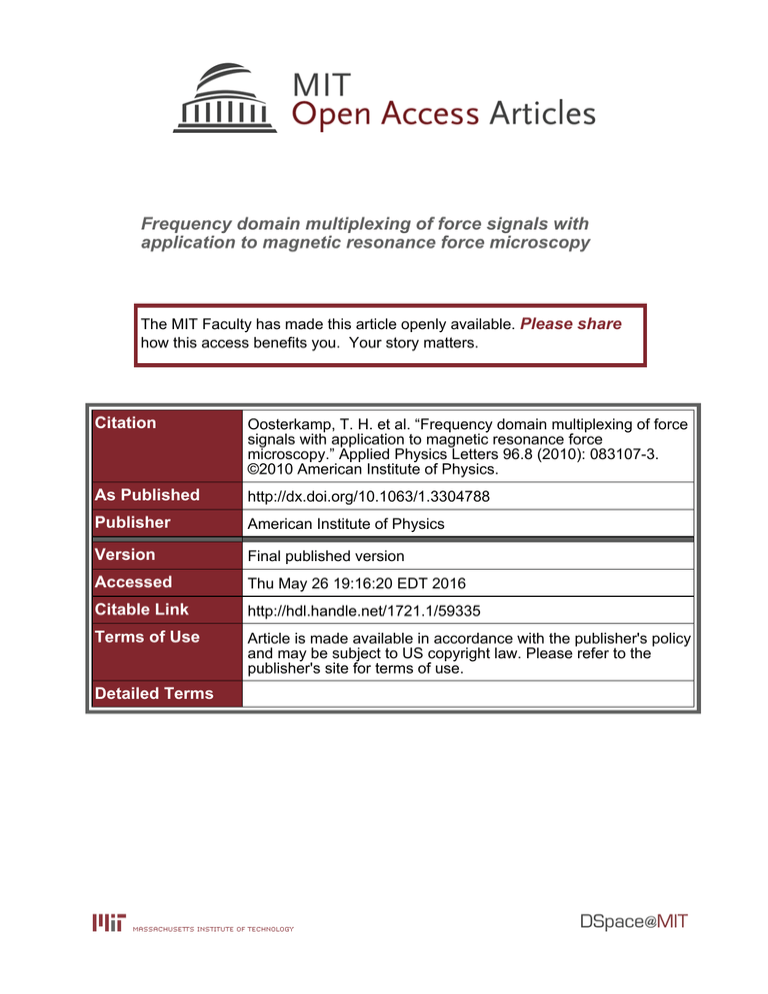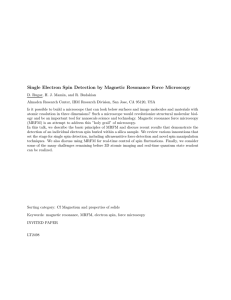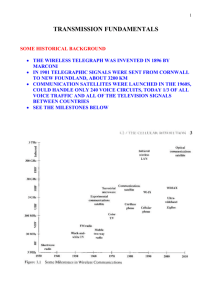Frequency domain multiplexing of force signals with
advertisement

Frequency domain multiplexing of force signals with application to magnetic resonance force microscopy The MIT Faculty has made this article openly available. Please share how this access benefits you. Your story matters. Citation Oosterkamp, T. H. et al. “Frequency domain multiplexing of force signals with application to magnetic resonance force microscopy.” Applied Physics Letters 96.8 (2010): 083107-3. ©2010 American Institute of Physics. As Published http://dx.doi.org/10.1063/1.3304788 Publisher American Institute of Physics Version Final published version Accessed Thu May 26 19:16:20 EDT 2016 Citable Link http://hdl.handle.net/1721.1/59335 Terms of Use Article is made available in accordance with the publisher's policy and may be subject to US copyright law. Please refer to the publisher's site for terms of use. Detailed Terms APPLIED PHYSICS LETTERS 96, 083107 共2010兲 Frequency domain multiplexing of force signals with application to magnetic resonance force microscopy T. H. Oosterkamp,1,a兲 M. Poggio,2 C. L. Degen,3 H. J. Mamin,3 and D. Rugar3 1 Leiden Institute of Physics, Leiden University, Niels Bohrweg 2, 2333 CA Leiden, The Netherlands Center for Probing the Nanoscale, Stanford University, 476 Lomita Mall, Stanford, California 94305, USA 3 IBM Research Division, Almaden Research Center, 650 Harry Rd., San Jose, California 95120, USA 2 共Received 27 October 2009; accepted 12 January 2010; published online 23 February 2010兲 Frequency domain multiplexing, using an actively damped micromechanical cantilever, is used to detect multiple force signals simultaneously. The measurement principle is applied to magnetic resonance force microscopy to allow concurrent measurement of nuclear spin signals originating from distinct regions of the sample, or from multiple spin species. © 2010 American Institute of Physics. 关doi:10.1063/1.3304788兴 Mechanical sensors, such as microcantilevers, are often operated at their mechanical resonance frequency in order to increase the signal amplitude and thermomechanical noise above the transduction and amplifier noise of the system. The benefit relies on having a mechanical resonance with a high quality factor Q. Unfortunately, the high quality factor can lead to an undesirably narrow intrinsic bandwidth. A much wider detection bandwidth can be recovered without degrading the noise performance by damping the mechanical oscillator using active feedback control.1,2 Depending on the intrinsic Q and the baseline detection noise level, the resulting bandwidth over which the noise performance is close to the thermal limit can be many times wider than the intrinsic oscillator bandwidth. In this letter, we show that if the oscillator is operated in a linear 共small signal兲 regime, it becomes possible to detect multiple narrow-band force signals simultaneously by frequency domain multiplexing, i.e., by putting each signal at a slightly different frequency within the bandwidth of the damped oscillator. We demonstrate this approach in the context of magnetic resonance force microscopy 共MRFM兲. MRFM was proposed3 and subsequently realized4 by combining the physics of magnetic resonance imaging with the techniques of scanning probe microscopy. The MRFM implementation employed here detects weak 共attonewton兲 magnetic forces generated by the cyclic inversion of statistically polarized nuclear spins.5,6 This type of detection was recently used to demonstrate three-dimensional 共3D兲 nuclear spin imaging of virus particles with spatial resolution better than 10 nm.7 Because the force levels are so small, relatively long measurement times 共tens of seconds兲 are typically required to distinguish the nuclear spin force from thermal forces. For this reason it can take several days to acquire a full 3D image with sufficient signal-to-noise ratio 共SNR兲.7 To improve data collection efficiency, Eberhardt et al.8,9 developed a spatial Hadamard encoding technique for MRFM that allows for either enhanced image acquisition rate or improved SNR. In addition, MRFM imaging methods based on Fourier encoding have been introduced.9,10 It is unclear to what extent these methods can be used when the spin polarization is statistical, which is the case for the highest resolution MRFM imaging.7,11 a兲 Electronic mail: oosterkamp@physics.leidenuniv.nl. 0003-6951/2010/96共8兲/083107/3/$30.00 As an alternative approach for improving data collection efficiency, we use an actively damped cantilever and frequency domain multiplexing to simultaneously detect independent sets of statistically polarized spins. Depending on the implementation, we can simultaneously measure spins at multiple sample locations or multiple nuclear species. As shown in Fig. 1, the MRFM experiment uses a sample-on-cantilever configuration. The test sample consists of a micrometer size CaF2 crystal that has been epoxied onto the end of an ultrasensitive silicon cantilever12 and coated with 30 nm of gold. Either 19F spins of the CaF2 sample or 1H spins in the epoxy can be detected by using frequency modulation of an rf magnetic field to cyclically invert the nuclear magnetization. With the sample positioned near a magnetic tip, the cyclic inversions result in an oscillating magnetic force that drives a subangstrom vibration of the cantilever. The rf magnetic field is generated by a “microwire” located below the magnetic tip.13 An external magnetic field of ⬃2.8 T from a large superconducting solenoid serves to magnetize the tip and adds to the total magnetic field. The cantilever vibration is detected by a fiber optic interferometer. FIG. 1. 共Color online兲 Configuration of the MRFM experiment. The sample on the end of the cantilever is positioned close to a 200 nm diameter FeCo magnetic tip sitting atop a copper microwire. Frequency modulation of an rf field from the microwire induces cyclic inversion of nuclear spins located within a thin resonant slice. The position of the resonant slice depends on the magnetic field from the tip, an external magnetic field, and the rf frequency. When several different rf frequencies are applied with distinct modulation frequencies, several slices can be addressed simultaneously. 96, 083107-1 © 2010 American Institute of Physics Downloaded 25 Mar 2010 to 18.51.1.222. Redistribution subject to AIP license or copyright; see http://apl.aip.org/apl/copyright.jsp Appl. Phys. Lett. 96, 083107 共2010兲 Oosterkamp et al. 10 10 10 1/fi -22 -22 2 force noisse [aN /Hz] fo orce noise [aN /H Hz] 250 rf freq 2560 (b) 200 i j f1 = 2582 2570 2580 Hz2590 1 = 114 MHz Frequency [Hz] time 2600 100 200 2560 2590MHz2600 113, 2580 114, 116 ((c)) j =2570 F Frequency [Hz] [H ] 150 100 2560 2570 2580 2590 Frequency [Hz] 300 200 =750 kHz 100 0 0 1 2 3 4 [MHz] 150 250 =1500 kHz 2 -21 -21 10 10 10 2 400 (a) spin signal [aN ] 2 2 position m position noise noise [m m /Hz] /Hz] [[m 083107-2 2600 FIG. 2. 共Color online兲 共a兲 Measured power spectral density of cantilever position showing narrow peak due to spin inversions on top of the broader background of thermal and measurement noise 共smooth curve兲. 共b兲 Spectral density in terms of equivalent force noise. Narrow peak is the spin signal. The dashed line denotes the thermal force noise while the smooth curve indicates the total system force noise. 共c兲 Spectral density of the force as in 共b兲, but now with three spin signals from independent sample regions driven by three simultaneous rf excitations. The inset to 共a兲 illustrates two concurrent rf frequency sweeps centered about i and j with peak-to-peak frequency modulation ⌬. At a measurement temperature of 4.2 K, the sampleloaded cantilever has a resonant frequency of 2.6 kHz, spring constant k = 86 N / m, and an intrinsic quality factor Q0 = 44, 000. The Q decreases to 9000 when the cantilever approaches to within 50 nm of the magnetic tip due to noncontact friction effects and eddy currents induced in the gold coating. To further improve measurement bandwidth, the cantilever is damped using active feedback to Qeff = 310. The feedback uses analog circuitry to produce an appropriately phase-shifted signal that drives a piezoelectric transducer located near the base of the cantilever.2 Using the principle of adiabatic rapid passage,14 the nuclear spins are cyclically inverted by frequency modulating the rf field with frequency sweeps having peak-to-peak frequency deviation ⌬ ⬃ 750– 1500 kHz 共Fig. 2 inset兲. We use multiple rf center frequencies i to address independent regions of the sample or to select between 19F and 1H nuclear species 共i ⬃ 110– 130 MHz兲. Associated with each rf center frequency is a distinct modulation repetition rate which serves to generate a force signal at a specific cantilever signal frequency f i ⬃ 2570– 2590 Hz. Since two rf frequency sweeps are required to complete one full cycle of spin inversion, the repetition rate of the modulation is set at twice the desired cantilever signal frequency. Mathematically, the rf waveform is given by B1共t兲 = 兺iAi共t兲cos关2兰t0i共t⬘兲dt⬘兴, where Ai共t兲 and i共t兲 represent rf amplitude and frequency, respectively, and are periodic functions with repetition frequency 2f i. The rf waveform is digitally synthesized at an intermediate frequency of ⬃20 MHz FIG. 3. 共Color online兲 Spin signal as a function of rf frequency separation for the case of excitation at two rf frequencies. Points show the forcedetected spin signal measured for 1 = 114 MHz in the presence of a second rf excitation that is offset in frequency by ␦. Results for two FM modulations ⌬ are shown. and upshifted to the operating frequency by mixing with a local oscillator 共⬃90 MHz兲. Figure 2共a兲 shows the spectral density of the cantilever vibration 共position noise兲 for the case of a single MRFM signal. The cyclic spin inversions result in a narrow peak in the spectral density. The spin signal, whose spectral width is inversely proportional to the rotating-frame spin lifetime m, sits atop a much broader peak due to the thermal vibrations of the damped cantilever. The vibration spectral density can be converted to force noise spectral density by dividing the vibration spectrum by the square of the cantilever transfer function, as shown in Fig. 2共b兲. The smooth solid curve represents the sum of the white thermal force noise 共dashed line兲 plus the detection noise. In terms of position, the detection noise is white, but when divided by the square of the cantilever transfer function the equivalent force noise increases quadratically away from the cantilever resonance frequency. Figure 2共b兲 shows that a single MRFM signal consumes only a small portion of the available bandwidth. The force noise bandwidth 共i.e., the bandwidth over which the force noise is within 3 dB of the minimum force noise兲 is approximately 50 Hz, or almost six times wider than the transfer function bandwidth of the actively damped cantilever 共Qeff = 310兲 and 170 times the bandwidth of the undamped cantilever 共Q = 9000兲. This seemingly remarkable result simply reflects the fact that cantilever thermomechanical noise dominates over detection noise for frequencies well beyond the 3 dB bandwidth of the cantilever transfer function. The lower the detection noise floor, the broader the bandwidth over which the thermomechanical noise dominates. Figure 2共c兲 demonstrates the simultaneous detection of three independent MRFM signals. Two of the signals have comparable amplitude, while the third signal, corresponding to 116 MHz rf center frequency, is smaller because it represents a resonant slice that addresses fewer spins. The slice at 116 MHz is physically located closer to the magnetic tip and barely intersects the end of the sample. In Fig. 3 we explore the effect on a spin signal by the presence of a second rf excitation. The points show a spin signal induced by rf frequency sweeps centered about 1 = 114 MHz. Simultaneously, a second spin signal 共not shown兲 is generated with rf frequency sweeps centered about 2 = 1 + ␦. The spin signal is found to be unaffected by the Downloaded 25 Mar 2010 to 18.51.1.222. Redistribution subject to AIP license or copyright; see http://apl.aip.org/apl/copyright.jsp 083107-3 Appl. Phys. Lett. 96, 083107 共2010兲 Oosterkamp et al. for narrow-band spin signals. In the future, an even higher degree of multiplexing should be possible with improved sensing techniques,15 which lower the detection noise relative to the thermomechanical noise, thus providing a wider effective bandwidth. We anticipate that frequency domain multiplexing could prove to be useful for other force sensing applications besides MRFM. 2 spin signal [aN ] 500 400 300 200 19 19 F 1 F H 100 0 115 120 125 rf frequency [MHz] FIG. 4. 共Color online兲 Simultaneous frequency scans of two nuclear species. With each solid diamond data point, exciting 19F spins, an additional open square data point was measured, exciting 1H spins. Points represent 20 min measurements taken simultaneously with two rf frequencies spaced by 7.2 MHz. The thin line represents data taken by scanning with a single rf frequency excitation. FM modulation was ⌬ = 1500 kHz. presence of the second rf excitation as long as ␦ ⬎ ⌬. As a further example of signal multiplexing, we demonstrate that two different nuclear species can be measured simultaneously. In Fig. 4 we show a magnetic resonance spectrum where the MRFM signal is measured as a function of the rf frequency. The thin line shows the result when only a single rf frequency is used. The two peaks represent the inhomogeneously broadened responses from the two nuclear species, 19F and 1H. The data was then retaken using two simultaneous rf excitations, represented by solid diamonds and open squares. The multiplexed data set is essentially identical to the data taken with only a single rf excitation, but needed only half the measurement time. In conclusion, we have demonstrated the simultaneous measurement of multiple MRFM signals using a single cantilever when the effective noise bandwidth of the cantilever is larger than the spin signal bandwidth. This multiplexing capability should result in a direct improvement of the measurement time required for 3D MRFM imaging, especially We acknowledge support from the European Research Council and the NSF-funded Center for Probing the Nanoscale at Stanford University 共Grant No. NSF PHY-0425897兲. 1 J. L. Garbini, K. J. Bruland, W. M. Dougherty, and J. A. Sidles, J. Appl. Phys. 80, 1951 共1996兲; K. J. Bruland, J. L. Garbini, W. M. Dougherty, and J. A. Sidles, ibid. 80, 1959 共1996兲. 2 M. Poggio, C. L. Degen, H. J. Mamin, and D. Rugar, Phys. Rev. Lett. 99, 017201 共2007兲. 3 J. A. Sidles, Phys. Rev. Lett. 68, 1124 共1992兲. 4 D. Rugar, C. S. Yannoni, and J. A. Sidles, Nature 共London兲 360, 563 共1992兲. 5 H. J. Mamin, R. Budakian, B. W. Chui, and D. Rugar, Phys. Rev. B 72, 024413 共2005兲. 6 C. L. Degen, M. Poggio, H. J. Mamin, and D. Rugar, Phys. Rev. Lett. 99, 250601 共2007兲. 7 C. L. Degen, M. Poggio, H. J. Mamin, C. T. Rettner, and D. Rugar, Proc. Natl. Acad. Sci. U.S.A. 106, 1313 共2009兲. 8 K. W. Eberhardt, C. L. Degen, and B. H. Meier, Phys. Rev. B 76, 180405共R兲 共2007兲. 9 K. W. Eberhardt, A. Hunkeler, U. Meier, J. Tharian, S. Mouaziz, G. Boero, J. Brugger, and B. H. Meier, Phys. Rev. B 78, 214401 共2008兲. 10 J. G. Kempf and J. A. Marohn, Phys. Rev. Lett. 90, 087601 共2003兲. 11 H. J. Mamin, M. Poggio, C. L. Degen, and D. Rugar, Nat. Nanotechnol. 2, 301 共2007兲. 12 B. W. Chui, Y. Hishinuma, R. Budakian, H. J. Mamin, T. W. Kenny, and D. Rugar, Technical Digest of the 12th International Conference on SolidState Sensors and Actuators (Transducers ’03) 共IEEE, Boston, 2003兲, p. 1120. 13 M. Poggio, C. T. Rettner, C. L. Degen, H. J. Mamin, and D. Rugar, Appl. Phys. Lett. 90, 263111 共2007兲. 14 C. P. Slichter, Principles of Magnetic Resonance, 3rd ed. 共Springer, New York, 1990兲, Chap. 2. 15 C. A. Regal, J. D. Teufel, and K. W. Lehnert, Nat. Phys. 4, 555 共2008兲. Downloaded 25 Mar 2010 to 18.51.1.222. Redistribution subject to AIP license or copyright; see http://apl.aip.org/apl/copyright.jsp





